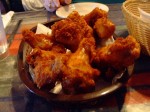Pricing Chicken Wings
 Photo: J Wynia
Photo: J WyniaI stopped by a local fried chicken joint, Harold’s Chicken Shack, the other day. Just to give you a sense of what sort of restaurant this is, there is a layer of bulletproof glass separating the workers and the customers. They don’t cook the chicken until you order, so I had five or ten minutes to kill waiting for my food.
One of the items on the menu is a chicken wing dinner. With each dinner, you get a fixed amount of french fries and coleslaw.
The two-wing meal costs $3.03. The three-wing meal costs $4.50.
Since the only difference between the two meals is one extra wing, that third wing is costing the customer $1.47. I thought this was interesting, because if each of the first two wings were priced at $1.47 each, then the implied price of the French fries and coleslaw is a combined 9 cents. So it seems like Harold’s is implicitly charging more for the third wing than for the first two wings, which is unusual since firms generally give quantity discounts.
I read further down the menu:
2-wing meal $3.03
3-wing meal $4.50
4-wing meal $5.40
5-wing meal $5.95
The four- and five-wing meal prices are more in line with how firms usually price.
So what do you think Harold’s charges for a six-wing meal? Here’s the answer:
2-wing meal $3.03
3-wing meal $4.50
4-wing meal $5.40
5-wing meal $5.95
6-wing meal $7.00
Definitely most bizarre. When economists see things that don’t make any sense, we can’t help but think of some story that rationalizes the seemingly odd behavior. Maybe Harold’s prices the 6-wing meal high because it is worried about obesity? Not likely, since every item on the menu is fried. Is the sixth wing especially big or tasty? Is demand by people who order six wings more inelastic?
Perhaps some clues could be found in the pricing of other items. Fried perch are sold in a similar fashion to fried chicken, with the choice of two, three, or four piece meals (again with french fries and cole slaw). Here is how perch is priced:
2-piece perch meal: $3.58
3-piece perch meal: $4.69
4-piece perch meal: $6.45
So you get that third piece of perch cheap, but they nail you on the fourth piece. This certainly hints at Harold’s thinking there is some logic to this sort of pricing.
Ultimately, though, my guess is that the person who chose these prices was just confused. One thing I have realized as I have worked more with businesses is that they are from the idealized profit maximizing automatons of economic theory. Confusion is endemic to firms. After all, firms are made up of people, and if people are confused most of the time by economics, why wouldn’t that carry over to firms?

Comments